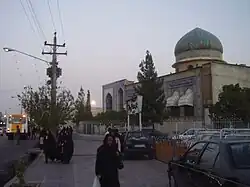Báb's house
The Báb's house (Persian: خانه باب), also known as Seyed Báb's house, in the Iranian city of Shiraz, was the home of Seyed Ali Mohammad Báb, founder of Bábism, where he openly proclaimed his religion for the first time.[1]

This house, which later became the most important Baháʼí pilgrimage destination in Iran,[2][3][4][5] was demolished on 1, September 1979,[6] during the Iranian Revolution.[7][8]
| Part of a series on the |
| Baháʼí Faith |
|---|
 |
|
Destruction
In the Kitáb-i-Aqdas Baháʼu'lláh declared this house a place for Baháʼí pilgrimage.[9] After major renovation in 1903, under the guidance of Abdu'l-Bahá, the house became Baháʼí's main pantheon.[10] During the next years this house was attacked by fanatics and was demolished.[10] In 1942 the house was the subject of arson. In 1955 in the midst of a series of persecutions of Baháʼís, which took place across Iran led by Mohammad Taghi Falsafi, the building was severely damaged. In September 1979, after Iran’s 1978 revolution, the house was completely knocked down by religious fanatics.[3][10]
Reaction of Baháʼí community
Following the demolition, in a letter dated 1 October 1979, “Iran’s Baháʼí National Circle” expressed their complaint over the house’s destruction.[8] Members of the National Circle who wrote this letter were kidnapped the next year and did not reappear.[8]
1979-
After 1979, the religion entered a new phase when a message of the Universal House of Justice dated 20 October 1983 was released. Baháʼís were urged to become involved in the social and economic development of their communities. In 1979, 129 officially recognized Baháʼí socioeconomic development projects were begun.[11][12]
The 1979 Islamic Revolution refocused the persecutions against the Baháʼí Faith. Several other Baháʼí holy sites were destroyed in the revolution's aftermath, including the house of Baháʼu'lláh at Takur (in Mazandaran), and the resting place of Muhammad-Ali Barfurushi (Quddús) in Tehran.[13]
Many Baháʼís were killed after the Islamic Revolution with many more imprisoned, expelled from schools and workplaces, denied various benefits or denied registration for their marriages.[14]
Since 2005, more than 1006 Baha'is have been arrested, The list of prisoners includes six members of a former leadership group serving the community. In 2010, the seven leaders of the community wrongly sentenced to 20 years in prison, the longest term then facing any prisoner of conscience in Iran. In late 2015, reports indicated that their sentences had been belatedly reduced from 20 years to 10 years.[15]
Other types of persecution include educational and economic discrimination; limits on the right to assemble and worship; and the dissemination of anti-Baha’i propaganda led by government news media. Attacks on Baha'is or Baha'i-owned properties, go without prosecution, creating a sense of impunity for attackers. Since 2005, for example, at least 52 incidents of arson were committed against Baha’i properties, crimes for which no one was arrested.[15]
See also
Further reading
- ʻAbdu'l-Bahá (1912). The Promulgation of Universal Peace (Hardcover ed.). Wilmette, Illinois, USA: Baháʼí Publishing Trust: 1982. ISBN 0-87743-172-8.
- Baháʼu'lláh (1976). Gleanings from the Writings of Baháʼu'lláh. Wilmette, Illinois, USA: Baháʼí Publishing Trust. ISBN 0-87743-187-6.
References
- "دین ایرانی" در کوه کَرمَل". BBC Persian (in Persian). 21 May 2007. Archived from the original on 2019-07-16.
- Kamrava, M.; Dorraj, M. (2008). Iran Today: An Encyclopedia of Life in the Islamic Republic. Greenwood Press. p. 192. ISBN 978-0-313-34163-2.
- Smith, Peter (2008). An introduction to the Baha'i faith. Cambridge University Press. p. 192. ISBN 978-0-521-86251-6. OCLC 181072578.
- "BAHAISM viii. Bahai Shrines". Encyclopaedia Iranica. Archived from the original on 17 November 2019. Retrieved 4 February 2020.
- Foltz, R. (2013). Religions of Iran: From Prehistory to the Present. Oneworld Publications. p. 240. ISBN 978-1-78074-309-7. Retrieved 2020-02-04.
- دیانتی ممنوع - آزار و تعقیب بهاییان در ایران. Ketab.co. 2009. p. ۸۳. ISBN 978-1-59584-193-3.
- "جنازههای بیتشییع؛ از احمد کسروی و بیژن جزنی تا مریم فیروز و هاله سحابی". BBC Persian (in Persian). 14 January 2020.
- "بهائیان و تشدید سرکوبها پس از انقلاب". BBC Persian (in Persian). 14 June 2019.
- "Baha'i News -- House of the Bab, Shiraz, Iran". bahai-library.com. Retrieved 9 February 2020.
- Smith, Peter (2000). "Shiraz the House of the Bab". A concise encyclopedia of the Bahá'í Faith. Oxford: Oneworld Publications. p. 314. ISBN 1-85168-184-1. Archived from the original on 1 April 2019.
- "The Bahá'í Faith 1957-1988: A Survey of Contemporary Developments". bahai-library.com. 1989.
- Smith, Peter; Momen, Moojan (2011-02-23). "The Baha'i faith 1957–1988: A survey of contemporary developments". Religion. 19: 63–91. doi:10.1016/0048-721X(89)90077-8.
- "The Specter of Ideological Genocide: The Bahá'ís of Iran*" (PDF). bahai-library.com/. 2005-01-01.
- "IRAN: DHABIHULLAH MAHRAMI: PRISONER OF CONSCIENCE". amnesty.org. 1996-09-30.
- "Situation of Baha'is in Iran". Bahá’í International Community. 14 October 2013.